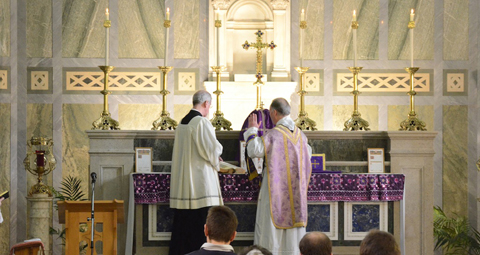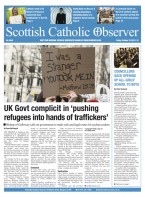January 27 | ![]() 0 COMMENTS
0 COMMENTS ![]() print
print

The traditional way to celebrate Mass is Extraordinary
DOROTHY CUMMINGS MCLEAN looks at how a new generation in Scotland is being attracted to the traditional rituals of the Latin Mass
While researching the diversity of Catholicism in Scotland, I was surprised by the overlap. Not everyone who goes regularly to Ukrainian Mass is Ukrainian. Syro-Malabar priests learn the Latin Rite to serve the Latin Rite majority. Catholic students are at home both in their university chaplaincies and in parishes. Polish-speakers are happy to go to Mass in English, and there are Scottish-Polish Catholic fellowship groups. Finally, there are those Latin Rite Catholics, of whatever nationality, who feel drawn to the Extraordinary Form of the Mass and practise Catholic devotions we now call ‘traditional.’
The history of the revival of the Traditional Latin Mass in Scotland begins in the heady days after the Second Vatican Council when dramatic changes swept through the Church’s liturgical and devotional practises.
In hindsight, the Missal of 1965 wasn’t revolutionary, but it sparked both the foundation of Latin Mass preservation societies and a spirit of liturgical experimentation. The Mass Paul VI promulgated in 1969 was so different from the Mass they knew that many Catholics felt deeply bereaved.
One such Catholic in Scotland was an influential convert named Mary Neilson (1912 – 2002). A member of a wealthy Presbyterian family in Edinburgh, she was (temporarily) disinherited by her parents when she converted to Catholicism in 1938.
Undaunted, she embarked on a career as a welfare officer, social worker and health researcher. In 1965, dubious of the changes proposed for the Latin Mass, she turned her considerable energies towards the preservation of the Old Rite. Not only did Miss Neilson help to establish the Scottish branch of the International Una Voce Federation, she offered her home in the West End as a centre of traditional worship.
The ‘Old Mass’ was said privately there by priests in good standing from 1970. When Miss Nielson died, she left the house to the Fraternity of the Priest of Saint Peter (FSSP), who maintain its chapel.
The preservation of the Traditional Mass has been complicated in Scotland by the presence of the Society of Saint Pius X (SSPX). The association of the ‘Old Mass’ with the SSPX, disobedience and schism has been hard on Catholics who practise the traditional devotions: to this day we suffer suspicious looks and sardonic remarks.
Fortunately, this prejudice has not been universal: in 2004, for example, Edinburgh’s Fr Michael Regan invited the FSSP to celebrate the Traditional Mass in St Andrew’s, Ravelston.
The promulgation of Summorum Pontificum in 2007 by Pope Emeritus Benedict XVI was a golden moment for lovers of traditional devotions. This short document praises earlier forms of the Latin Rite, declares that the Missal of 1962 was never abrogated, describes its Mass as the ‘extraordinary’ form of the Latin Rite and gives generous provisions for its use. Pope Benedict’s enthusiasm for tradition brought a new generation into contact with the Extraordinary Form and its community.
Civil servant Mark Hamid, 28, first encountered the Extraordinary Form in Oxford in 2007. “It was a revelation,” he told me.
As a university student, he invited the FSSP to bring the Extraordinary Form from Edinburgh to St Andrews. The Mass was made available to students from 2011 until 2016, when attendance dropped off. This was in part because there were more activities for students on Sunday afternoons, but also because of the popularity of the Extraordinary Form (EF) Mass now celebrated in Dundee. Since then Hamid has organised the ‘Two Shrines Pilgrimage,’ a Scottish version of the Walsingham pilgrimage organised by England’s Latin Mass Society.
Glasgow physicist Gerald Bonner, 30, first witnessed the Extraordinary Form in 2011 at an Australian Catholic students’ conference in Sydney. Initially he found it confusing. “I probably attended about five EF Masses before really getting into the rhythm,” he admitted.
Asked what he gets from the EF, Mr Bonner was expansive. “The rich beauty of the prayers and the ritual in the EF reveal so clearly that the Mass is the re-presentation of the Sacrifice of Calvary,” he said. “The chants, the silences, the posture of the priest all serve to draw you into that mystery and make it easier to participate in it fully.
“While most of these things are possible in the Ordinary Form, they are more reliably found in the Extraordinary Form, which is less dependent on the style of the priest.”
The EF has also had a positive effect on Mr Bonner’s experience of the Ordinary Form which, due to time constraints, he attends more often: “Not only do I understand its roots better, I can participate more deeply having experienced the Old Rite.”
Ian and Kristiina Watt, 26, of Glasgow are professional musicians who became Catholics two years ago after approaching the FSSP priest in Edinburgh. “We were interested in the Traditional Mass before coming into the Church,” Ian said, “attracted by its beauty and historical continuity, two aspects of Catholicism which influenced both our conversions.”
Kristiina added: “As a musician, the beautiful Catholic legacy of art and music intended for the traditional Mass was often a source of inspiration and assurance for me during the period leading up to our [reception].”
“I don’t know if it is correct to speak of ‘Traditional Latin Mass (TLM) communities’ as such,” Ian said, “but the presence of the TLM seems to be a sign of overall health in a diocese or parish community.
“For example, the parish at which this Mass is offered most frequently in Glasgow, six times a week in addition to the daily parish Ordinary Form (OF) Mass, is notable for its provision of regular solid catechesis, scheduled Confessions before and after every Mass, weekly Vespers and Benediction, seasonal devotions and outreach to the homeless and vulnerable, all provided by just one parish priest with the help of volunteers.”
Immaculate Heart of Mary, Balornock, is an example of how traditional devotions can be fully integrated into a Scottish parish. In 2007, Summorum Pontificum inspired its pastor, Fr Morris, to say the Extraordinary Form twice a week.
These Masses attracted a ‘small but stable group of the faithful,’ reported the church organist Fraser Pearce. “Soon after this the parish gained the support of Una Voce and things grew from there.”
As no OF Masses were cancelled to make room for the EF, there was no protest. Today there are daily EF Masses (except on Mondays) at Immaculate Heart.
“We have lots of social events and outings in addition to catechetical talks on Sunday evenings, and people who attend either Mass share together in these,” Mr Pearce said. Immaculate Heart also runs its own food bank—’We have fed up to as many as 15 families a week’—and delivers donations of household goods.
The parishioners help the Sisters of Charity in their Glasgow soup kitchen and host three annual meals for homeless men. “We seek to imitate Our Lord in practising the corporal acts of mercy while keeping in mind that our primary mission is the salvation of souls,” Mr Pearce explained.
“These meals are usually preceded by a short service in which we pray for the souls of those men who have died since the previous occasion.”
In addition to Masses in both Forms, Vespers and Benediction, Immaculate Heart parish offers the Exposition of the Blessed Sacrament on Mondays and the Rosary and Confession on Friday evenings.
“We also have First Saturday Devotions as requested by Our Lady of Fatima,” Mr Pearce said. The parish even has a ceremony crowning the statue of Our Lady in May.
“Immaculate Heart runs a full programme of all the traditional devotions that were part of Catholic life until recent years,” Mr Pearce explained.
And who are the Catholics who flock to all this old-fashioned stuff?
“People of all ages, professionals, unemployed people and students from across the West of Scotland,” Mr Pearce said. “We have several young married couples and a good few converts who come into the Church looking for the fullness of the traditional Faith and found it here. We have people who travel from as far as Edinburgh and Ayr several times each week.
“In the last nine months we have gained many new parishioners as well as friends of the parish who are able to visit depending on circumstances… I don’t think that anyone is attached by nostalgia.”
I myself have gone to the FSSP Sunday Mass at St Andrew’s, Ravelston, since I moved to Scotland. I like to say that I ‘married into the Mass,’ since I never went to the EF before I married my convert husband. Having read a lot of classical Catholic theology, I soon felt at home in the traditional rite.
In no way has this cut me off of from the rest of the Church. Indeed, if I can’t make it to the noon Mass at St Andrew’s, I can usually be found at Polish Mass at St Mary’s Cathedral.










